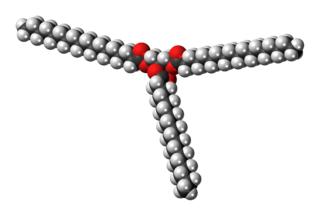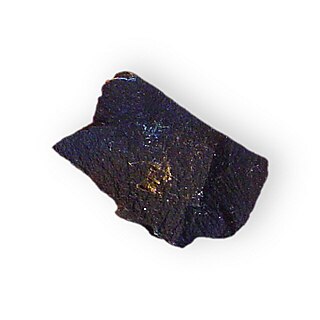
Paraffin wax is a soft colorless solid derived from petroleum, coal, or oil shale that consists of a mixture of hydrocarbon molecules containing between 20 and 40 carbon atoms. It is solid at room temperature and begins to melt above approximately 37 °C (99 °F), and its boiling point is above 370 °C (698 °F). Common applications for paraffin wax include lubrication, electrical insulation, and candles; dyed paraffin wax can be made into crayons. It is distinct from kerosene and other petroleum products that are sometimes called paraffin.

Etching is traditionally the process of using strong acid or mordant to cut into the unprotected parts of a metal surface to create a design in intaglio (incised) in the metal. In modern manufacturing, other chemicals may be used on other types of material. As a method of printmaking, it is, along with engraving, the most important technique for old master prints, and remains in wide use today. In a number of modern variants such as microfabrication etching and photochemical milling, it is a crucial technique in modern technology, including circuit boards.

Beeswax is a natural wax produced by honey bees of the genus Apis. The wax is formed into scales by eight wax-producing glands in the abdominal segments of worker bees, which discard it in or at the hive. The hive workers collect and use it to form cells for honey storage and larval and pupal protection within the beehive. Chemically, beeswax consists mainly of esters of fatty acids and various long-chain alcohols.

Waxes are a diverse class of organic compounds that are lipophilic, malleable solids near ambient temperatures. They include higher alkanes and lipids, typically with melting points above about 40 °C (104 °F), melting to give low viscosity liquids. Waxes are insoluble in water but soluble in nonpolar organic solvents such as hexane, benzene and chloroform. Natural waxes of different types are produced by plants and animals and occur in petroleum.

Waxed paper is paper that has been made moisture-proof and grease-proof through the application of wax.

Edison Records was one of the early record labels that pioneered sound recording and reproduction, and was an important and successful company in the early recording industry.

Stearin, or tristearin, or glyceryl tristearate is an odourless, white powder. It is a triglyceride derived from three units of stearic acid. Most triglycerides are derived from at least two and more commonly three different fatty acids. Like other triglycerides, stearin can crystallise in three polymorphs. For stearin, these melt at 54 (α-form), 65, and 72.5 °C (β-form).

Hair wax is a thick hairstyling product containing wax, used to assist with holding the hair. In contrast with hair gel, most of which contain alcohol, hair wax remains pliable and has less chance of drying out. It is often sold under names such as pomade, putty, glue, whip, molding gum, or styling paste. The texture, consistency, and purpose of these products varies widely and each has a different purported purpose depending on the manufacturer. Traditionally, pomade is a type of hair wax that also adds shine to one's hair.

A drying oil is an oil that hardens to a tough, solid film after a period of exposure to air, at room temperature. The oil hardens through a chemical reaction in which the components crosslink by the action of oxygen. Drying oils are a key component of oil paint and some varnishes. Some commonly used drying oils include linseed oil, tung oil, poppy seed oil, perilla oil, and walnut oil. Their use has declined over the past several decades, as they have been replaced by alkyd resins and other binders.

Purified water is water that has been mechanically filtered or processed to remove impurities and make it suitable for use. Distilled water was, formerly, the most common form of purified water, but, in recent years, water is more frequently purified by other processes including capacitive deionization, reverse osmosis, carbon filtering, microfiltration, ultrafiltration, ultraviolet oxidation, or electrodeionization. Combinations of a number of these processes have come into use to produce ultrapure water of such high purity that its trace contaminants are measured in parts per billion (ppb) or parts per trillion (ppt).

Ozokerite or ozocerite, archaically referred to as earthwax or earth wax, is a naturally occurring odoriferous mineral wax or paraffin found in many localities. Lacking a definite composition and crystalline structure, it is not considered a mineral but only a mineraloid. The name was coined from Greek elements Όζω ozο, to stink, and κηρός keros, wax.
Phenol extraction is a laboratory technique that purifies nucleic acid samples using a phenol solution. Phenol is common reagent in extraction because its properties allow for effective nucleic acid extraction, particularly as it strongly denatures proteins, it is a nucleic acid preservative, and it is immiscible in water.
An oil is any nonpolar chemical substance that is composed primarily of hydrocarbons and is hydrophobic and lipophilic. Oils are usually flammable and surface active. Most oils are unsaturated lipids that are liquid at room temperature.

The grease pencil, a wax writing tool also known as a wax pencil, china marker, or chinagraph pencil, is a writing implement made of hardened colored wax and is useful for marking on hard, glossy non-porous surfaces. This pencil is usually made from non-toxic opaque wax that is similar to a crayon but stronger. Marks made by grease pencils are resistant to moisture and can usually be removed by rubbing the marked surface with a paper towel.

Shilajit or salajeet or mumijo or mumie is natural organic-mineral product of predominantly natural biological origin, formed in the mountains.

In chemistry, fractional crystallization is a stage-wise separation technique that relies on the liquid-solid phase change. It fractionates via differences in crystallization temperature and enables the purification of multi-component mixtures, as long as none of the constituents can act as solvents to the others. Due to the high selectivity of the solid - liquid equilibrium, very high purities can be achieved for the selected component.

Parchment paper, vegetable parchment, or, baking paper is a cellulose-based composite that has been processed to give it additional properties including non-stickiness, grease resistance, and resistance to humidity. It is commonly used in baking as a disposable non-stick, grease resistant surface. It should not be confused with waxed paper, which is paper that has been coated in wax.
Carboceric acid, or heptacosanoic acid or heptacosylic acid, is a 27-carbon long-chain saturated fatty acid with the chemical formula CH
3(CH
2)
25COOH. Its name derives from a combination of the word "Carbon" and κηρός (Keros), meaning beeswax or honeycomb in Ancient Greek, since the acid can be found in the mineral ozokerite, also known as ozocerite.

Aquaphor is a brand of over-the-counter (OTC) skin care ointments manufactured by Beiersdorf Inc., an affiliate of Beiersdorf AG. Aquaphor is offered in four product ranges: There are two skin protectant ointments. Aquaphor Original Ointment, used as a compounding agent and Aquaphor Advanced Therapy Healing Ointment, sold in mass retail outlets. The other product ranges include: Aquaphor Lip Repair and Lip Repair + Protect SPF 30, and Aquaphor Baby.
Edible oil refining is a set of processes or treatments necessary to turn vegetable raw oil into edible oil.
















